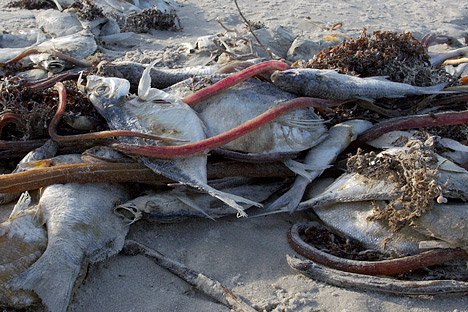

Phytoplankton are the foundation of the aquatic food web, the primary producers, feeding everything from microscopic, animal-like zooplankton to multi-ton whales. Small fish and invertebrates also graze on the plant-like organisms, and then those smaller animals are eaten by bigger ones.
Phytoplankton can also be the harbingers of death or disease. Certain species of phytoplankton produce powerful biotoxins, making them responsible for so-called “red tides,” or harmful algal blooms. These toxic blooms can kill marine life and people who eat contaminated seafood.

Dead fish washed onto a beach at Padre Island, Texas, in October 2009, following a red tide (harmful algal bloom). (Photograph ©2009 qnr-away for a while.)
Phytoplankton cause mass mortality in other ways. In the aftermath of a massive bloom, dead phytoplankton sink to the ocean or lake floor. The bacteria that decompose the phytoplankton deplete the oxygen in the water, suffocating animal life; the result is a dead zone.
Through photosynthesis, phytoplankton consume carbon dioxide on a scale equivalent to forests and other land plants. Some of this carbon is carried to the deep ocean when phytoplankton die, and some is transferred to different layers of the ocean as phytoplankton are eaten by other creatures, which themselves reproduce, generate waste, and die.

Phytoplankton are responsible for most of the transfer of carbon dioxide from the atmosphere to the ocean. Carbon dioxide is consumed during photosynthesis, and the carbon is incorporated in the phytoplankton, just as carbon is stored in the wood and leaves of a tree. Most of the carbon is returned to near-surface waters when phytoplankton are eaten or decompose, but some falls into the ocean depths. (Illustration adapted from A New Wave of Ocean Science, U.S. JGOFS.)
Worldwide, this “biological carbon pump” transfers about 10 gigatonnes of carbon from the atmosphere to the deep ocean each year. Even small changes in the growth of phytoplankton may affect atmospheric carbon dioxide concentrations, which would feed back to global surface temperatures.